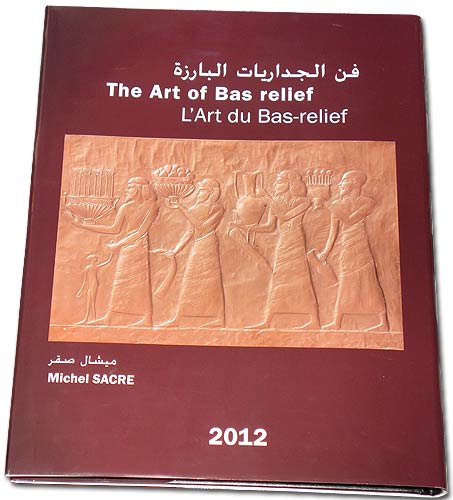The Temple of Civilizations (From the book, Michel Sacre: The Art of Bas-relief)
I wanted to present a simple and quick overview of my project on the history and ancient civilizations. In short, it consists of coming up with new interpretations of history dating back to 5000 years BC. My project is divided into two parts:
Part one: the Imitation
The imitation is a true copy of the old sculptures and paintings that are exhibited in world museums. I did my best to render the exact images in order to come up with new historical interpretations.
Five thousand years ago, artists used to carve sculptures or draw paintings to express themselves. Several historians attempted to interpret the works of ancient artists writing several articles about them. Given their various mental and artistic abilities, each one of them would present their own explanation dissimilar to those of the others.
My interpretation differs from theirs with regard to the imitation of bas-relief sculptures. In fact, when I am chiseling an imitation of any piece of art, I interact with it as if I were the artist who created it. Hence, if the painting was Assyrian, for example, I feel like I am the Assyrian artist who drew it, and if it was Persian, I become the Persian artist. In other words, I live their experiences and their visions by incorporating and understanding them and by merging them into my psychological state and vital space since my imitation is meticulous and comes in various sizes. It is worth signaling, against this backdrop, that imitating a piece of art is far from being easy. What you are seeing are all bas-reliefs, intricately detailed, given that they are the pure expression of the Middle Eastern civilizations, carved at a time when artists would only draw or chisel something in order to express themselves as they did not know how to write yet. Thus, one could say that the artifacts are the symbols used by their creators in order to express their ideas and opinions.
Why did I choose to work this way?
First of all, because of my origins: I am a believer, artistically committed to the cause of beauty, sciences, and history. After the imitation, and following numerous readings on history and world civilizations, I noticed that there is a lack or even omission, whether intentional or not, of some information. I, therefore, tried to find new interpretations for my bas-reliefs. I don't mean to say that my explanations are true and others are false. In fact, they either complete or discard each other. I only help the viewer by giving him two pieces of art; mine and the old one. I am thus helping him draw the right conclusions. Up until now, I have come to new interpretations of three of my bas-reliefs. However, how would I know if they were really new? The recent interpretation of the sculpture named ''Sargon II'' was compared to the old one mentioned in some history books and references that I own. My work would help reveal historical facts, and I hope that it would be appreciated by historians, researchers, and students majoring in the study of ancient civilizations. Sometimes, I succeed in interpreting some pieces of art without immersing myself in them, either because they were carefully studied before, or because I wasn't touched by them or by the artists who created them.
Part two: the creation
Some bas-reliefs portray well, known ancient myths that really took place and are far from being simple illusions. In fact, if they were so they should be completely forgotten. However, given that they are real, we need to respect and protect them, like the legend of Adonis and Ishtar, whose sculpture is full of my subjective reactions. As for the story of King Salomon and the queen of Saba, nothing proves that it is true. Nevertheless, I have included this sculpture in order to express political and historical ideas. I have restored this sculpture in my own way and explained it again according to my personal vision that differs from that of ancient artists. My drawings help understand history as I have modernized those civilizations with the use of contemporary techniques. I think that man is incapable of creating. Surely the mother carries the baby and gives birth to him, however, she doesn't create him. The creation, in fact, is only in the hands of God, and if the man succeeds in his attempt of creation, he becomes a god or a sparkle from God. In other words, he would only become a young god. When Michael Angelo was carving Moses, he looked at it startled, hit its knee with the chisel and shouted: ''Moses, speak!''. Indeed, a soul needs to be breathed into this sculpture for it to speak. Still, the man is not a creator but rather an author and a concept designer. Hence, the artist expresses his ideas and vision through his work. But this could never take place if the latter wasn't affected by a situation, or if he doesn't live, in his human dimension, any local, national or international event. On the other hand, he should not be affected by hard times, since the resulting artwork would be destructive, and since the artist, himself can certainly be a referee or a judge. We, therefore, understand the impact of his work on humanity, the nation, and the coming generations.
My project aims, in general, at building a temple for civilizations. Yet achieving this goal requires a lot of work. Indeed, fifteen years have already gone by, and it is still far from being attained.
Michel Sacre's bas-reliefs could not be sold, unlike the copied versions. The original pieces are exhibited in his museum ''the Temple of Civilizations'' in Bentael (daughter of Baal).

